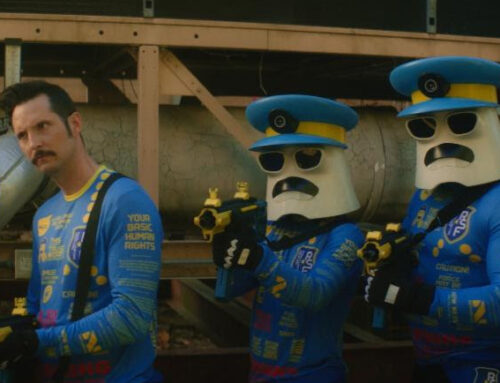If all these horror films have taught me anything, it is that there are evil children out there, and we should be wary of them. The Bad Seed, The Good Son, Goodnight Mommy, The Omen, Village of the Damned, The Prodigy, and, yes, We Need to Talk about Kevin all demonstrate that some kids are just born bad. And so it seems with ten-year-old Markuss (Damir Onackis), a young Latvian boy being raised by his grandmother (Dace Eversa). The films opens with a neighbor (Inese Kucinska-Lauksteine) seeking her lost daughter, Emilija (Luize Birkenberga), later returning to accuse Markuss of pushing the daughter into the eponymous pit in the woods behind their houses. Markuss’s eyes are dead, black holes that express no remorse, guilt or concern. “This kid’s gonna kill everybody,” I figured.
Okay, The Pit, you got me. Through flashbacks and slow revelations about Markuss’s history, we learn he is not a sociopath, just a lost and lonely kid, unwanted by his mother, abandoned by his junkie father before that man died. His grandmother’s neighbor’s son, Roberts (Egons Dombrovskis) is a spousal abuser who realizes too late the consequences of his actions. Markuss is a gifted artist, and while fleeing bullies encounters Sailor (Indra Burkovska), a recluse who lives out in the woods. He and Sailor begin an uneasy friendship, and again I assumed I knew where we were going. It’s not an evil kid film; it’s a coming of age film. The kid gets the cranky old man to experience life again; the cranky old man helps the kid grow in confidence and wisdom. Got it!
Nope. I will not reveal the twists that come, but while The Pit is a coming of age film, it is unlike any I had seen before. The secrets of the older generation begin to be revealed, and one realizes the title does not just refer to the hole in the woods, but the village itself. Behind closed doors all sorts of horrible things happen.
Meanwhile, while Sailor is teaching Markuss how to make stained glass, Sandra (Inese Kucinska-Lauksteine), the neighbor whose daughter went into the pit, attempts to rally the community to have the boy declared a danger – his drawings show a disturbed mind, sha claims. How and why does she have his art, they ask? She manages to poison the well against Marcus, even as her own son bullies the boy, beating him at every opportunity.
I went into this film expecting a horror film; then I thought I was watching a coming of age film; but then, just as at the film’s conclusion the stained glass window Markuss and Sailor have been working on is unveiled and you realize all the little images add up to a single, significant portrait, the film reveals itself to be the same: all of these people and moments have been presented to show a far bigger picture than the individual moments. Love, support, and acceptance are not ongoing realities but moment-by-moment choices. And the film reflects on how consequences of actions can change those choices.
The film is beautifully shot, and contains many creative moments (the increasing number of dead flies on Markuss’s windowsill marking the passage of time until the film shows he has a dead butterfly and imagines himself as the butterfly and the townspeople as the flies, for example – very effective in the moment). Credit is also due to Onackis who endows Markuss with an initial creepy and disturbing vibe, shifting to make the character more and more sympathetic until by the end of the film he literally deserves a medal.
So The Pit ain’t The Bad Seed; more like My Life as a Dog, but still a very worthwhile watch if you like good film.
9 out of 10
| The Pit | ||
| RATING: | NR |
THE PIT Trailer | PÖFF 2020 |
| Runtime: | 1 Hr. 47 Mins. | |
| Directed By: | ||
| Written By: | ||







